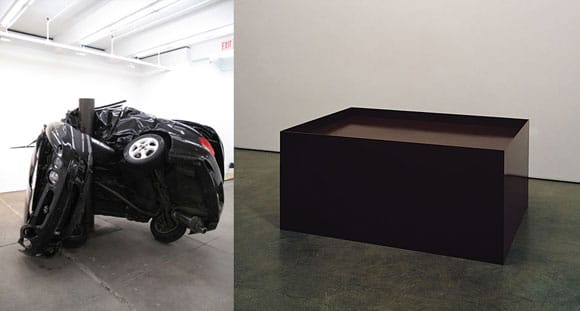Die Die Die: A Survey
This is an artist’s essay that explores some of the ideas put forward in Powers’ three-part essay, “Art, Not Suicide,” published earlier this week. -Ed. Note
Editor’s Note: This is an artist’s essay that explores some of the ideas put forward in Powers three part “Art, Not Suicide” essay published earlier this week (Part 1, Part 2, Part 3).

“Sculpture is dead.” — John Powers
“Nothing grows under big trees.” — Constantin Brancusi

“A thing is a hole in a thing it is not.” — Carl Andre
“What should replace the missing object?” — Wassily Kandinsky, Reminiscences
“The world is like a hole and the hole itself is not hollow.” — Kazimir Malevich, God Is Not Cast Down

“Let us throw away monuments, sidewalks, arcades, steps: let us sink squares into the ground, raise the level of the city.” — Tommaso Marinetti and Antonio Sant’Elia, “Manifesto on Futurist Architecture”
“I’m interested for the most part in what’s not happening, that area between events which could be called the gap. This gap exists in the blank and void regions or settings that we never look at. A museum of different kinds of emptiness could be developed. The emptiness could be defined by the actual installation of the art. Installations could empty rooms not fill them.” — Robert Smithson, “What is a Museum” (1967)
“Minimal art was only trying to answer Pollock’s challenge and to capitalize on what lay latent and undeveloped in his work – that is, to expand the holism and purity into communal practice. If Pollock had been the prophet, minimalism was the church … The practitioners of pop art were farting in church.” — Robert Morris, “Size Matters” (2000)

“ … The dead were burnt and their ashes placed inside of the sacred totem poles … Slaves used to be sacrificed in the post holes.” — Kalervo Oberg, The Social Economy of the Tlingit Indians

“When Christians built Churches on the sites of pagan sanctuaries, incorporating the old capitals and columns in their naves, they were behaving as Hercules had with the Nemian lion, or Athena with Gorgon. In the hero’s relationship with the monster, what matters is this: … To kill the monster means to incorporate it in oneself, to take its place.” — Roberto Calasso, The Marriage of Cadmus and Harmony

“Speaking of the hidden by means of the hidden, Is this not content?” — Wassily Kandinsky, Complete Writings

“I looked around at everyone bathed in the blood red light of the back room. Dan Flavin had conceived his installation in response to the mounting death toll of the war in Vietnam. No one in the backroom was slated to die in Vietnam, though few would survive the cruel plagues of a generation.” — Patti Smith, Just Kids (2010)

“We dropped abstraction off its sacred throne ’and spat on its altar.” — El Lissitzky, “Abstraction in the Twentieth Century”

“And finally, above all else, it is about leaving a mark that I existed: I was here. I was hungry. I was defeated. I was happy. I was sad. I was in love. I was afraid. I was hopeful. I had an idea and had a good purpose and that is why I made art.” — Felix Gonzalez-Torres in an interview with Tim Rollins (1993)




